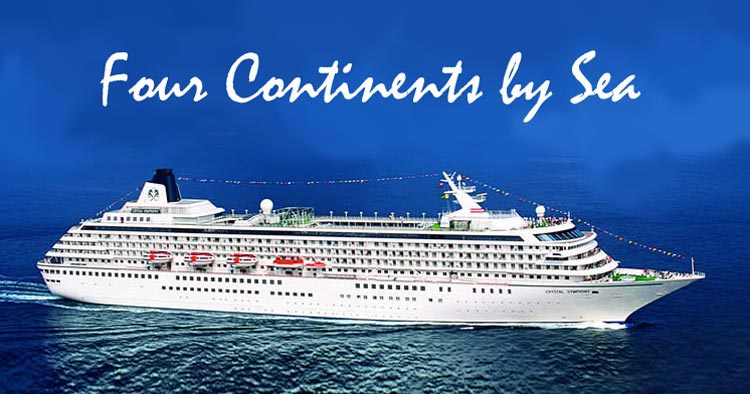 |
visits to Italy, France, Spain, Gibraltar, Morroco,
Teneriffe, Brazil, Barbados & Dominica
|
 |
visits to Italy, France, Spain, Gibraltar, Morroco,
Teneriffe, Brazil, Barbados & Dominica
|
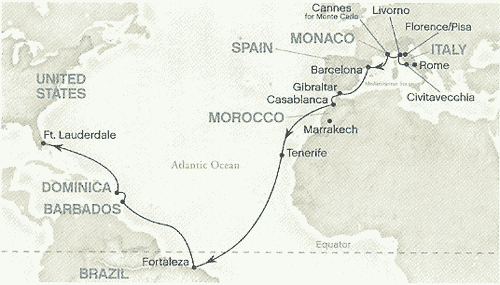 Early in 2009 we received notice
of an exceptionally inexpensive cruise that travelled four
continents of the world. Being the bargan hunter I am, I
realized that we couldn't pass this up because it was a samplier
of areas that we've wanted to travel too. It would cover
most of the Mediterranean then drop down to Equatorial Atlantic,
Brazil and up through the Carribean.
Early in 2009 we received notice
of an exceptionally inexpensive cruise that travelled four
continents of the world. Being the bargan hunter I am, I
realized that we couldn't pass this up because it was a samplier
of areas that we've wanted to travel too. It would cover
most of the Mediterranean then drop down to Equatorial Atlantic,
Brazil and up through the Carribean.
Travel was on the Grand Princess as a "Relocation Voyage" moving the ship to the Carribean for the winter. Ham radio, Echolink was included but a secondary priority. Amateur operation from many of these countrys is allowed under the CEPT agreement.
We embark on the ship in the Port of Civitavecchia which is
about 40 miles from Rome. No one in their right mind would
travel all the way to Italy and not spend time in one of the
world's great cities, yet we met people who didn't want to spend
time there but just met the ship the same day as their arrival.
Rome was the highlight of our trip and we spent 3 extra days
there. Probably the most impressive aspect was all the
buildings are made of stone and very old. Streets were often
cobblestone, traffic was a challenge with many scooters and crazy
Italian drivers. Our hotel had only 20 rooms and run
as an Italian family business with great service. We gained
many tips from them as to good places to eat, shop, etc. We
had WiFi right to our room and I made Echolink connections while
Marsha slept. Overall, they made us feel very welcome.
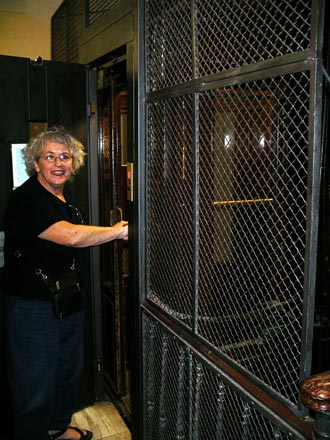 |
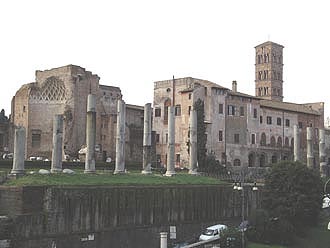 |
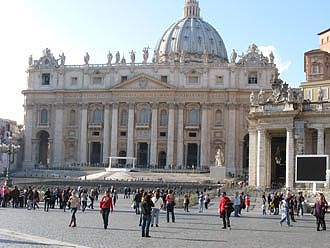
|
| Marsha operating hotel cage elevator | Ruins near Areo di Tito |
St. Peter's Square, Vatican |
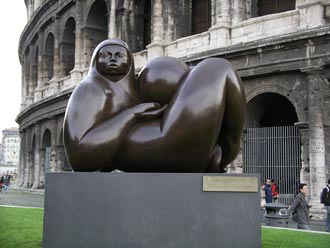 |
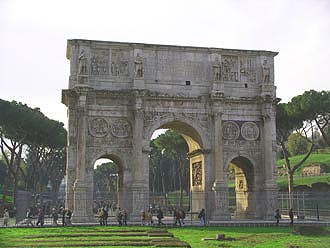 |
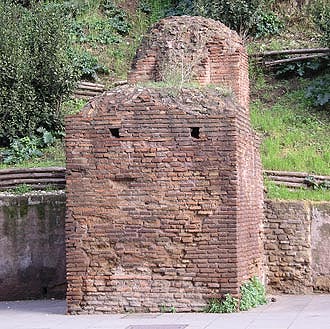 |
| Statue in front of Colosseum |
Arch of Costantino | Ruins near Collesium |
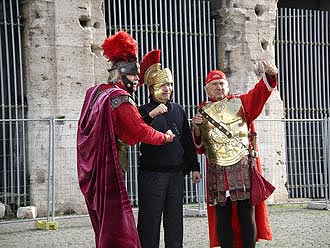 |
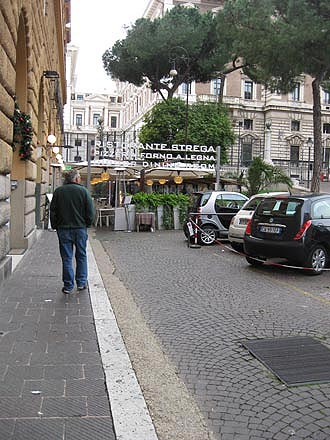 |
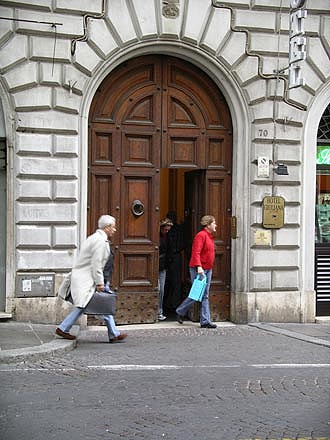 |
| Gladiators at Colosseum |
Neil, streets of Rome and home to thin crust Pizza |
Street entrance to our hotel |
Vatican: Being an admirer of Galileo, Newton, Kepler and others that the Catholic Church dishonored, it's clear to me that they are the most backward organization in existance then and now. I choose not to contribute a dime to their cause so we didn't go inside their dungeon. What a con game they're playing. The Pope has yet to address child abuse in the church - they continue shielding pedophile clergy from prosecution. One of these days followers will realize this and what a miserable organization this church is.
Reaching the port of Lovorno, you can go to Pisa or Florence
which is the capitol of Tuscany. Not being interested in
leaning buildings, we went to the latter.
History: It was during the reign of Julius Caesar that Florence came into existence in the year 59 B.C. he established a colony along the Arno where the famous "ponte vecchio" crosses the Arno river today. The Romans established Florence as an important trading centre around the third century A.D.
In the fifth century, the peaceful and prosperous lives of these early Florentines came to an abrupt end as the Roman Empire of the West crumbled before the waves of Barbarian conquerors coming from northern Europe . The Dark Ages had begun, and with it was lost Italian unity for nearly 1400 years.
During these hard times, Charlemagne and his Frankish forces in the eighth century A.D. crushed the last of the Barbarian kings of Italy . But, this reprieve was short lived. In giving thanks, Pope Leo III made a terrible mistake that was to lead to another prolonged period of disharmony and conflict. To secure Charlemagne's loyalty, the Pope gave him the title of Holy Roman Emperor.
Most of Italy came under the rule of the Emperor, and this led to future conflicts between the Emperor and the Pope that was to drive the Italians into their own version of a civil war. The population of Florence was divided over their loyalty between the two factions. And so in Florence different factions formed.
Typical of the innovative skills and determination of the Tuscan's, Florence enjoyed a booming economy with a population of 100, 000. The mainstay of the local economy was the wool trade. At the end of the 14th Century, led by members of the wealthy merchant class, political life in Florence became the realm of artists and intellectuals that planted the seeds for the birth of the Renaissance.
During this period, the Medici family rose to power. As leaders of Florence , their dynasty lasted nearly 300 years. Cosimo de' Medici was a successful banker who endowed religious institutions with artworks. During the reign of his grandson Lorenzo il Magnifico, Florence was caught by an artistic and intellectual fervor that created the Renaissance movement.
After the Renaissance, Florence was ruled by a series of ineffective leaders that left it in the wake of the other great cities of Italy and Europe . During the reunification of Italy in the 19th century, it was made temporarily capital of Italy until Rome finally joined the newly created Italy.
Like the tourists who visit Florence today, the city still relives those years when the likes of Michelangelo, Leonardo da Vinci, Dante, Botticelli, Donatello and many others helped change the world forever. Thankfully, the last of the Medici, Anna Maria who died in 1743, arguably gave the greatest gift to the city of Florence. In her will she bequeathed all the Medici property to the city on the agreement that they would never leave the city.
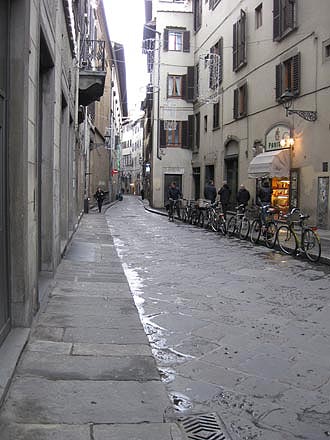 |
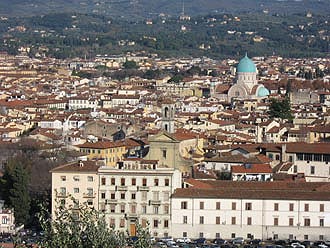 |
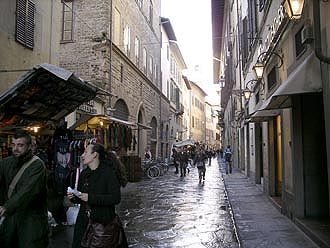 |
| 2,000 year old streets |
Skyline of Firenze |
lorgo dei Greci |
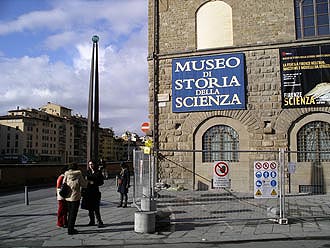 |
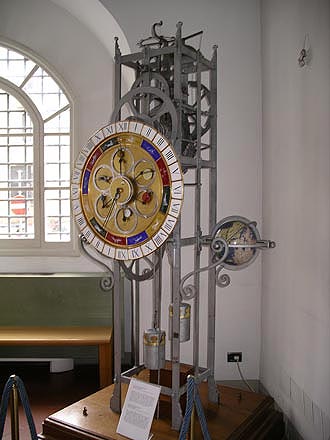 |
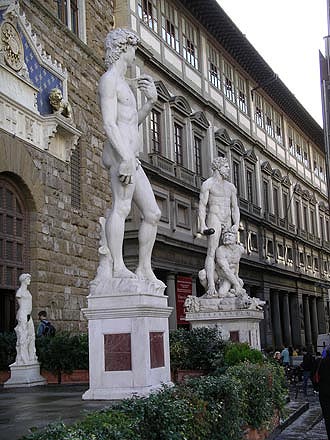 |
| Museum: History of Science Details: http://www.imss.fi.it |
Reproduction: Lorenzo della Volpaia timepiece from 16th century | Orcagna's Loggia near Uffizi Gallery |
I found Florence overwhelming in so many ways. Many of the
great scientists came from or had ties to this city. To walk
the streets in the foot steps of so many great leaders of many
disiplines, including wars is moving. You would have to
write books to tell the story. Most people come here for the
rich collection of art such as found in the Uffizi Gallery.
I concentrated on the science and an overview of the city.
Part of the French Riviera, its noted for its outstanding climate and wealthy residents. This is the site of the famous annual Cannes Film Festival.
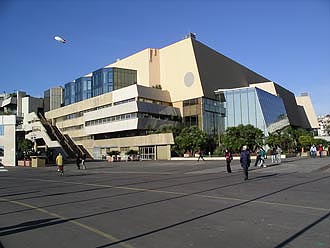 |
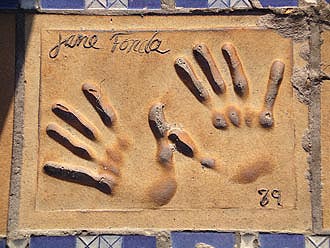 |
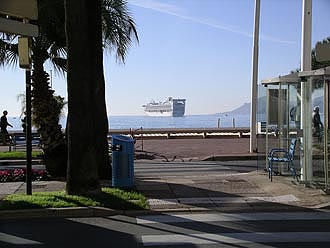 |
| Auditorium--Cannes Film Festival |
Jane Fonda Impression |
Our ship in the sunny harbor |
Celebrites and movie stars want to be seen here. Other than
being a nice clean city with a few casinos its much like other
resorts on the Mediterranean. Too expensive for my
blood.
As the capital and cultural hub of the autonomus region of
Catalonia, the city has a long and glorious history of its
own. The Catalin language is simular to Spanish, but also
has much in common with southern French dialects. Both
Catalan and Castilian Spanish are spoken.
Barcelona is a bustling and cosmopolitan place, a center of
experimentation in politics and art. Having held the world's
fair some years ago, many improvements have been made such as the
cruise ship terminal which is probably the best in the
world. Antoni Gaudi was one of the great artists and his
work can be seen all over Barcelona. His most famous is the
La Sagrada Familia. Its still unfinished after over 100
years but will be a most impressive structure when
completed.
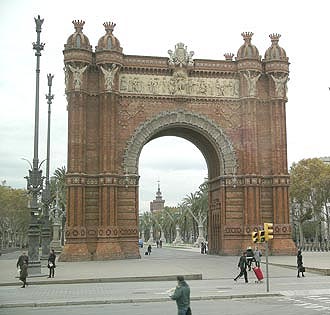 |
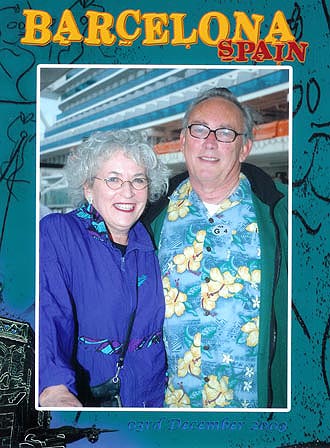 |
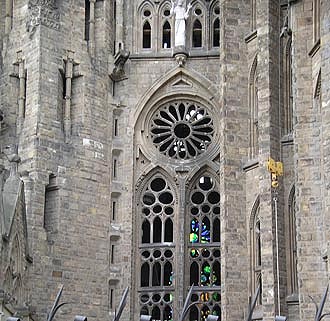 |
| The Arc de Triomf | Ships photo | Facade of La Sagrada Família |
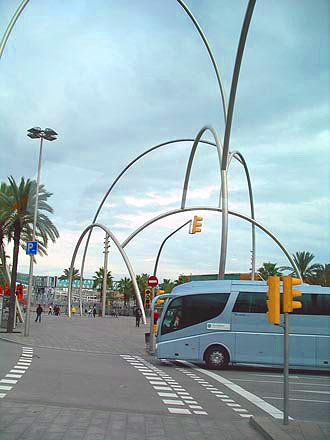 |
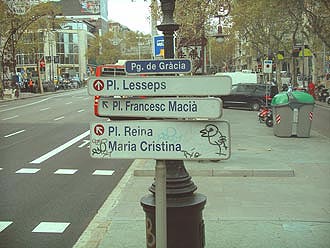 |
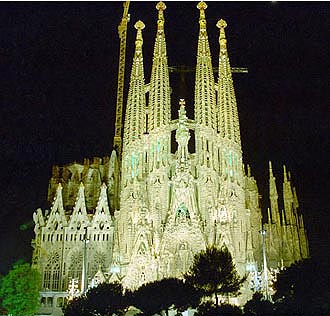 |
| Modern Art | Which way do I go? |
Night view of Unfinished church of the Sagrada Família |
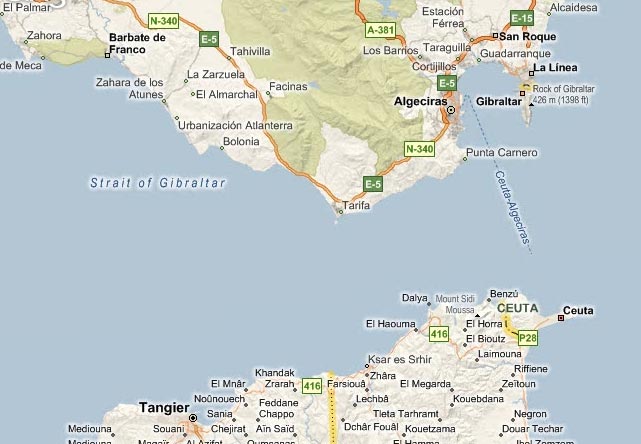 A most interesting place
with only 3 square miles of land to the East of Algeciras, Spain.
Its claimed by Great Britian. The Strait of Gibraltar is the
entrance to the Mediterranean and offers great stategic value from
a military point of view. Its been under contention over the
centuries principally from Spain and France. Its only 8
miles to North Africa. One surprize for me was that its not
located at the narrowest point of the strait, in fact it sits back
a ways. The monitoring and control of German "U" boats was
an important role during WWII.
A most interesting place
with only 3 square miles of land to the East of Algeciras, Spain.
Its claimed by Great Britian. The Strait of Gibraltar is the
entrance to the Mediterranean and offers great stategic value from
a military point of view. Its been under contention over the
centuries principally from Spain and France. Its only 8
miles to North Africa. One surprize for me was that its not
located at the narrowest point of the strait, in fact it sits back
a ways. The monitoring and control of German "U" boats was
an important role during WWII.
The town has a population of about 30,000 made up of Spaniards,
Moors, Arabs and British. The "Rock of Gibralter" is 1,396
feet high with a sheer vertical face to the East. A tram
takes you to the top where you will find outstanding views across
to North Africa, the city below and Spain to the West. A
well known resident are the monkeys which are native to North
Africa but have lived on the rock for many years. Theirs
about 300 of them. They are known to be superb "pick
pockets" and will often reach into your pocket if they think
you're carrying anything they would enjoy. Its quite common
for them to be extremely fast while jumping on your shoulder to
find "goodies". They do bite if you resist.
Gibraltar is self contained including their fresh water
source and electrical power. Spain has cut off power in the
past when relationships have gone sour. Water is collected
from the rain but they also have a desalination plant just in
case. Streets are very narrow and represent ages of
occupation by different people. Since space is so limited,
you get a congested feeling in town.
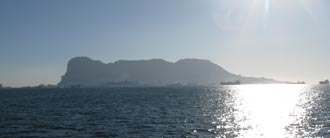 |
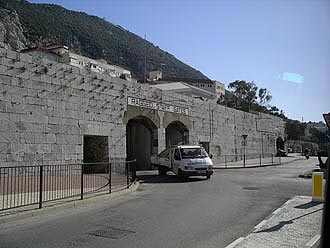 |
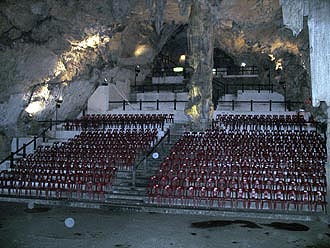 |
| Approaching "The Rock" from sea |
Access to defense caves |
Amphitheater, St. Michael's Cave |
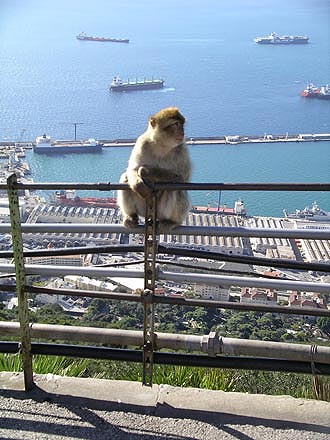 |
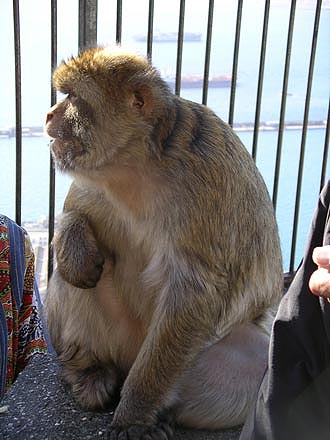 |
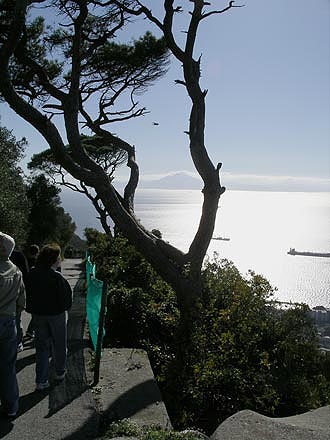 |
| Barbary Apes of Gibraltar |
Looking for handouts |
Top of "The Rock", North Africa in distance |
St. Michael's Cave inside "the rock" offer entertainment much of
the year. Sound quality is not the best because the cave
walls reflect so well.
Marsha went on a dolphin trip because of her knee. A trip
to the rock involves plenty of walking. You take the tram to
the top and walk part way down to observe the sights, apes and
caves.
Last modified: 03/18/10